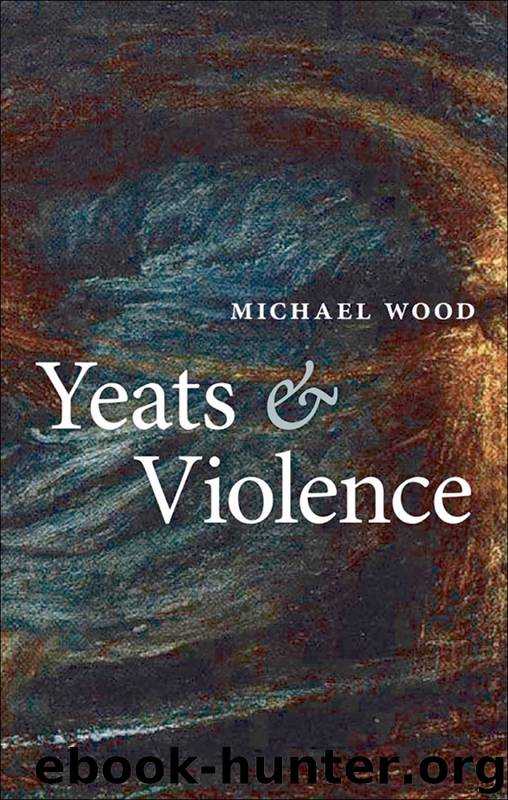Yeats and Violence by Wood Michael;

Author:Wood, Michael;
Language: eng
Format: epub
Publisher: Oxford University Press USA - OSO
The last stress is very faint but our ear has become accustomed to five beats and easily supplies it. But what about taking the line as an absolutely regular iambic one? Then we get
Man ís in lóve and lóves what vánishés …
A little more strident, more anxious, less stately—although we get this effect by following a convention almost too literally.
Metrical difficulty arises in ‘Nineteen Hundred and Nineteen’ when the stanza form itself becomes uncomfortable, as Helen Vendler says of the second and third parts of the poem. The capaciousness of the same stanza in ‘All Soul’s Night’ arises chiefly from the easy alternation of regular rhythm and changing line-length; and when the rhythm breaks from regularity, it breaks into extra emphasis rather than getting lost. This is how the spondees work, and how the opening lines, in particular, acquire what Paul Muldoon calls their ‘extraordinary combination of the incantatory and the carefree’.52 But this is not at all the feeling the stanza creates in ‘Nineteen Hundred and Nineteen’. So many lines here sound like prose that we wonder not only how to scan them but whether they should be scanned at all: ‘Some moralist or mythological poet’; ‘I am satisfied with that’. It’s only when we read the rhyme on ‘poet’, and reach the repetition of ‘satisfied’ that we realize that formal or musical demands are being made of us, and we wonder what they are. But the effect begins earlier, with the opening line of Part II. No spondees here, and no rhythm at all that’s easy to settle on:
When Loie Fuller’s Chinese dancers enwound …
There are all kinds of interesting snags in the line. Loie sounds as if it might be a monosyllable, so we are not quite sure where to go with it. Chinese seems to require the pronunciation Chínese if the line is to get launched. And wound is a little perturbing, with its uncertain phonetics, double meaning, and odd prefix. Still, we can get to a scansion if we have to:
When Lóie Fúller’s Chínese dáncers enwóund …
Four iambs and an anapaest; or in Derek Attridge’s terminology, a five-beat line with an extra off-beat towards the end. It does feel as if we are working too hard, though, and it may be worth imagining what this line’s regular if imaginary cousin might look like:
When Láura Fúller’s éager dáncers wóve …
It’s clear that Yeats wanted his awkwardness, and indeed it runs through the whole of the two parts using this stanza. A beat does get established in this second part, and indeed the rhythm of the second line repeats that of the first exactly, if more gracefully, establishing a pattern (’A shíning wéb, a flóating ríbbon of áir’), and the third line, with its two anapaests (’It séemed that a drágon of áir) positively skips. And then all is well until the last line but one of this part:
All men are dancers and their tread …
It scans readily enough into four beats (All mén are dáncers ánd
Download
This site does not store any files on its server. We only index and link to content provided by other sites. Please contact the content providers to delete copyright contents if any and email us, we'll remove relevant links or contents immediately.
4 3 2 1: A Novel by Paul Auster(12281)
The handmaid's tale by Margaret Atwood(7678)
Giovanni's Room by James Baldwin(7189)
Asking the Right Questions: A Guide to Critical Thinking by M. Neil Browne & Stuart M. Keeley(5632)
Big Magic: Creative Living Beyond Fear by Elizabeth Gilbert(5610)
Ego Is the Enemy by Ryan Holiday(5294)
The Body: A Guide for Occupants by Bill Bryson(4974)
On Writing A Memoir of the Craft by Stephen King(4863)
Ken Follett - World without end by Ken Follett(4645)
Adulting by Kelly Williams Brown(4487)
Bluets by Maggie Nelson(4472)
Eat That Frog! by Brian Tracy(4434)
Guilty Pleasures by Laurell K Hamilton(4360)
The Poetry of Pablo Neruda by Pablo Neruda(4038)
Alive: The Story of the Andes Survivors by Piers Paul Read(3968)
White Noise - A Novel by Don DeLillo(3953)
Fingerprints of the Gods by Graham Hancock(3940)
The Book of Joy by Dalai Lama(3899)
The Bookshop by Penelope Fitzgerald(3775)
